When I took the students to the airport and checked them to security—free at last, and convinced that the experience had been transforming—I returned to the city, where I’ve been busy ever since. Yesterday afternoon, I walked for about three hours. My main goal was to climb Coal Hill and take pictures overlooking the Forbidden City. At one time the highest location in the city, Coal Hill was constructed of dirt dug out of the moat to build the Palace. It offers the best view of the Palace, and I was delighted that it had been reopened since I was there two years ago. I realized I had not been there late in the day before (I like to get there early in the morning and watch the tai qi and line dancing and ballroom dancing, and calligraphy, etc., but couldn’t entice any night owls to join me). One note of history there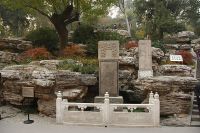 —supposedly, the last Ming emperor went there when the Manchu armies seized the city in 1644 and hanged himself. Interestingly, the Manchus had him buried in the same valley with the other Ming tombs, and carried on the burial traditions themselves, becoming more Chinese than Manchu by the end of the dynasty (they came and were transformed).
—supposedly, the last Ming emperor went there when the Manchu armies seized the city in 1644 and hanged himself. Interestingly, the Manchus had him buried in the same valley with the other Ming tombs, and carried on the burial traditions themselves, becoming more Chinese than Manchu by the end of the dynasty (they came and were transformed).
I went around the Forbidden City to Sun Yat sen Park, which had been part of the Palace when the Emperors lived there, when it housed an altar for 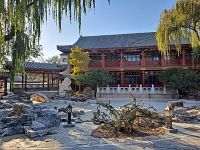 earth and grain. Another stupendous architectural wonder—and proof that the Middle Kingdom, or its rulers at any rate, was wealthy beyond belief. I emerged just in time to witness the lowering of the flag over Tiananmen Square, which had a larger crowd than in the morning (after all, 7:30 at night is preferable to most people over 4:50 a.m.), the same snappy military detail, but no inspiring anthem, or any music.
earth and grain. Another stupendous architectural wonder—and proof that the Middle Kingdom, or its rulers at any rate, was wealthy beyond belief. I emerged just in time to witness the lowering of the flag over Tiananmen Square, which had a larger crowd than in the morning (after all, 7:30 at night is preferable to most people over 4:50 a.m.), the same snappy military detail, but no inspiring anthem, or any music.
Today was my “OMG, I’m outnumbered by how many to one?” day. I left early this morning for the thing I’ve never had time to do—visit the Qing tombs. There are two sets, one in Eastern Hebei province, which were ravaged during the warlord period, partly because one of the graves is of Cixi, the wicked Empress Dowager who poisoned emperors to keep power, the other in Western Hebei. I went to the west, where we visited the tomb of 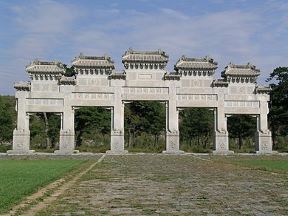
Y ongzheng, the 3rd Qing emperor, and supposedly the most resplendent. He set up the first tomb in the area (supposedly, he killed his brothers when he became emperor; it wasn’t always primogeniture, making succession one of the problems in any dictatorship, or even an entrepreneurial company. Consequently, he did not want to bury himself near his father). Yongzheng designed the Sacred Way after the model of the Mings (who copied earlier dynasties) with some differences; most notably, the scholar/officials had the “pigtail,” the Manchu hairstyle that the dynasty made every Han Chinese copy. The tomb was every bit as impressive as the more well-traveled Ming tombs, but being 70 miles or so from Beijing, much less visited by tour groups. They told me I was the only Westerner to have been there that day.
ongzheng, the 3rd Qing emperor, and supposedly the most resplendent. He set up the first tomb in the area (supposedly, he killed his brothers when he became emperor; it wasn’t always primogeniture, making succession one of the problems in any dictatorship, or even an entrepreneurial company. Consequently, he did not want to bury himself near his father). Yongzheng designed the Sacred Way after the model of the Mings (who copied earlier dynasties) with some differences; most notably, the scholar/officials had the “pigtail,” the Manchu hairstyle that the dynasty made every Han Chinese copy. The tomb was every bit as impressive as the more well-traveled Ming tombs, but being 70 miles or so from Beijing, much less visited by tour groups. They told me I was the only Westerner to have been there that day.
Fragrant Hill was similar. Another imperial park, it is on a hillside in another playground (my guide thought the problem with the Qing emperors was that they had too many playgrounds and did not spend enough time on government; after all, they permitted the century of humiliation!), this one 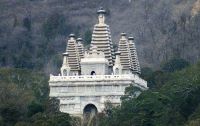
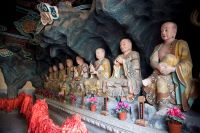
built by Qianlong. With a charming man-made lake (and a natural mountain, of over 1,200 meters, which we did not have enough time to climb or to ride the cable car to the top). The site houses the Azure Cloud temple. It’s another lama temple Qianlong built (partly to honor his mother), with Tibetan stupas; Dr. Sun Yat sen’s body rested here while the Republic prepared the elegant tomb in the capital (between the late 20s and 1949). Again, it was a park full of local people (it was Sunday afternoon), and I was the only American around. Beijing abounds with imperial sights, just as impressive as those on the tour, but more enjoyable because they’re not.
Right now, I am the only Westerner on a train headed (for me anyway) to Shanhaiguan, the mountain-sea pass where the Great Wall comes down to the sea. I’m spending tonight there, and visiting the pass, Qinwangdao (the only city named for the first emperor in his lifetime) and Beidahe, playground along the ocean of old and new elites. The car is a second-class sleeper (6 people, 6 bunks; fortunately I’ve got a bottom bunk), and if I speak English, I talk only to myself. I am, after all, in China.
I hope you’re enjoying your holiday as much as I am mine.